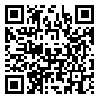Volume 19, Issue 1 (Vol.19, No.1, Spring 2023)
irje 2023, 19(1): 1-14 |
Back to browse issues page
Download citation:
BibTeX | RIS | EndNote | Medlars | ProCite | Reference Manager | RefWorks
Send citation to:



BibTeX | RIS | EndNote | Medlars | ProCite | Reference Manager | RefWorks
Send citation to:
Najafizadeh S, Ahmadi Tabatabaei S V, Dehnavieh Tijang F, Noori Hekmat S. Workforce Estimation for Healthcare Providers Using Workload Indicators of Staffing Needs in Kerman City in 2017. irje 2023; 19 (1) :1-14
URL: http://irje.tums.ac.ir/article-1-6580-en.html
URL: http://irje.tums.ac.ir/article-1-6580-en.html
Sahar Najafizadeh1 
 , Seyed Vahid Ahmadi Tabatabaei2
, Seyed Vahid Ahmadi Tabatabaei2 
 , Fatemeh Dehnavieh Tijang3
, Fatemeh Dehnavieh Tijang3 
 , Somayeh Noori Hekmat *
, Somayeh Noori Hekmat * 
 4
4

 , Seyed Vahid Ahmadi Tabatabaei2
, Seyed Vahid Ahmadi Tabatabaei2 
 , Fatemeh Dehnavieh Tijang3
, Fatemeh Dehnavieh Tijang3 
 , Somayeh Noori Hekmat *
, Somayeh Noori Hekmat * 
 4
4
1- Health Services Management Research Center, Institute for Futures Studies in Health, Kerman University of Medical Sciences, Kerman, Iran
2- Social Determinants of Health Research Center, Institute for Futures Studies in Health, Kerman University of Medical Sciences, Kerman, Iran
3- Health Informatics Research Center, Institute for Futures Studies in Health, Kerman University of Medical Sciences, Kerman, Iran
4- Health Services Management Research Center, Institute for Futures Studies in Health, Kerman University of Medical Sciences, Kerman, Iran ,snhekmat@gmail.com
2- Social Determinants of Health Research Center, Institute for Futures Studies in Health, Kerman University of Medical Sciences, Kerman, Iran
3- Health Informatics Research Center, Institute for Futures Studies in Health, Kerman University of Medical Sciences, Kerman, Iran
4- Health Services Management Research Center, Institute for Futures Studies in Health, Kerman University of Medical Sciences, Kerman, Iran ,
Abstract: (905 Views)
Background and Objectives: Human resources play a crucial role in delivering optimal healthcare services to the population. Expanding primary healthcare coverage requires a heightened focus on the healthcare workforce due to their pivotal role in service delivery. This study aims to evaluate the current workload and staffing requirements for primary health workers and midwives in Kerman, Iran, employing the Workload Indicators of Staffing Need (WISN) methodology.
Methods: A descriptive cross-sectional study was conducted in four selected health centers in Kerman, Iran, to estimate staffing requirements across two categories. A total of 118 activities for primary health workers and 89 activities for midwives were identified through the collaboration of expert panels and a comprehensive review of the Iran’s integrated health system. Subsequently, all activities were meticulously timed in each of the four health centers using stopwatches, and WISN ratios and proportions were calculated using Microsoft Excel 2010.
Results: The WISN calculations revealed a surplus in the number of primary health workers in three of the centers: B, C, and D. However, in center A, the workforce in this category is deemed sufficient. Conversely, a deficiency of midwives was noted in two centers, A and B, with WISN ratios of 0.67 and 0.50, respectively, while center C demonstrated an excess of the workforce with a WISN ratio of 2.00. Notably, an average of 50% of the staff workload in both categories comprises supportive and additional activities.
Conclusion: Interestingly, despite 75% of the cases indicating an excess or sufficiency of employees, staff members continue to grapple with high work pressures. This anomaly appears to be linked to the substantial volume of support and additional activities. Furthermore, the intense workload during specific days and hours translates into a pervasive sense of pressure throughout the week. As a potential remedy, introducing a queuing system into the primary healthcare sector could alleviate this issue.
Methods: A descriptive cross-sectional study was conducted in four selected health centers in Kerman, Iran, to estimate staffing requirements across two categories. A total of 118 activities for primary health workers and 89 activities for midwives were identified through the collaboration of expert panels and a comprehensive review of the Iran’s integrated health system. Subsequently, all activities were meticulously timed in each of the four health centers using stopwatches, and WISN ratios and proportions were calculated using Microsoft Excel 2010.
Results: The WISN calculations revealed a surplus in the number of primary health workers in three of the centers: B, C, and D. However, in center A, the workforce in this category is deemed sufficient. Conversely, a deficiency of midwives was noted in two centers, A and B, with WISN ratios of 0.67 and 0.50, respectively, while center C demonstrated an excess of the workforce with a WISN ratio of 2.00. Notably, an average of 50% of the staff workload in both categories comprises supportive and additional activities.
Conclusion: Interestingly, despite 75% of the cases indicating an excess or sufficiency of employees, staff members continue to grapple with high work pressures. This anomaly appears to be linked to the substantial volume of support and additional activities. Furthermore, the intense workload during specific days and hours translates into a pervasive sense of pressure throughout the week. As a potential remedy, introducing a queuing system into the primary healthcare sector could alleviate this issue.
Type of Study: Research |
Subject:
Special
Received: 2020/09/15 | Accepted: 2023/10/11 | Published: 2023/06/10
Received: 2020/09/15 | Accepted: 2023/10/11 | Published: 2023/06/10
Send email to the article author
| Rights and permissions | |
 |
This work is licensed under a Creative Commons Attribution-NonCommercial 4.0 International License. |



